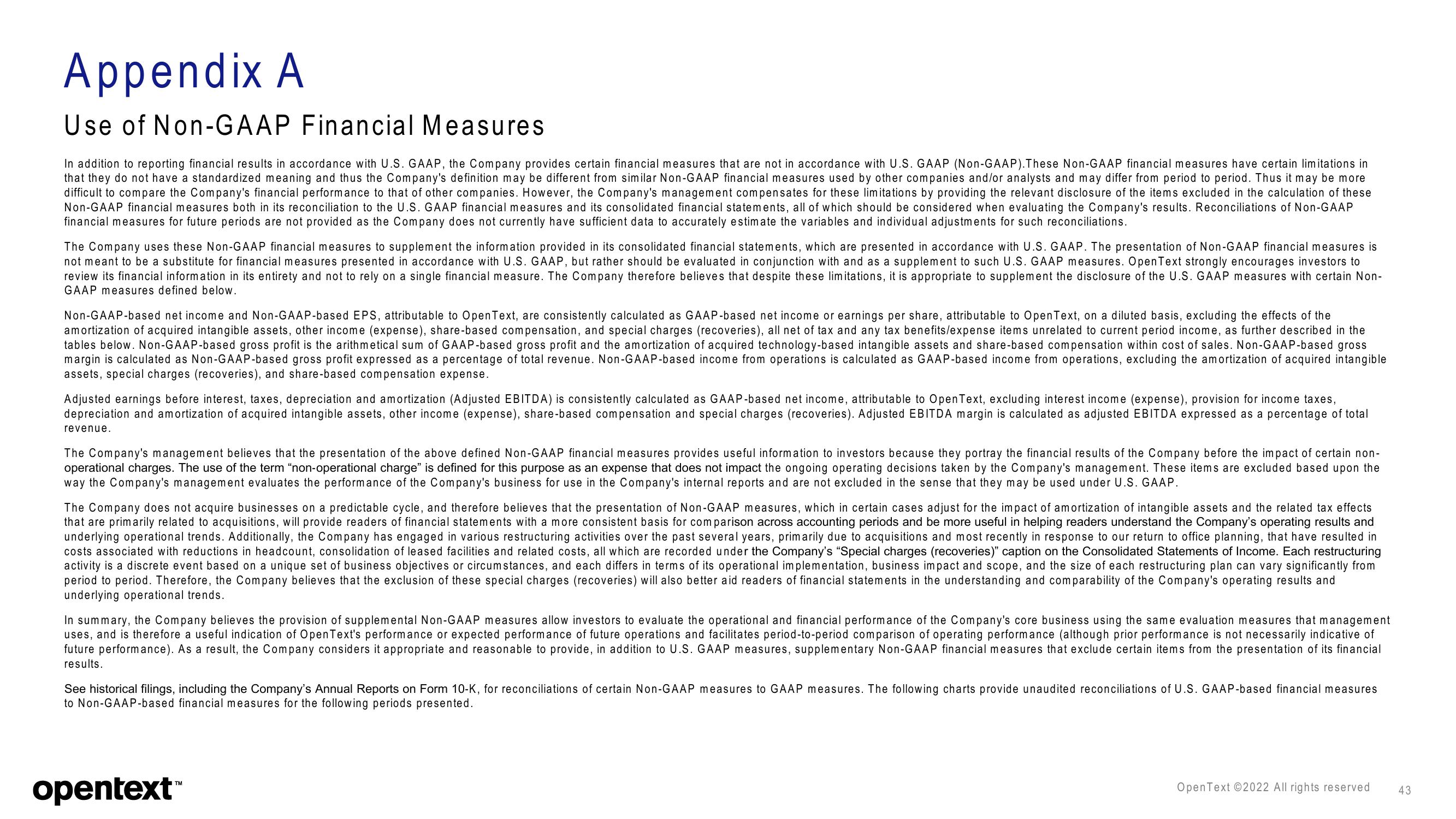OpenText Investor Presentation Deck
Appendix A
Use of Non-GAAP Financial Measures
In addition to reporting financial results in accordance with U.S. GAAP, the Company provides certain financial measures that are not in accordance with U.S. GAAP (Non-GAAP). These Non-GAAP financial measures have certain limitations in
that they do not have a standardized meaning and thus the Company's definition may be different from similar Non-GAAP financial measures used by other companies and/or analysts and may differ from period to period. Thus it may be more
difficult to compare the Company's financial performance to that of other companies. However, the Company's management compensates for these limitations by providing the relevant disclosure of the items excluded in the calculation of these
Non-GAAP financial measures both in its reconciliation to the U.S. GAAP financial measures and its consolidated financial statements, all of which should be considered when evaluating the Company's results. Reconciliations of Non-GAAP
financial measures for future periods are not provided as the Company does not currently have sufficient data to accurately estimate the variables and individual adjustments for such reconciliations.
The Company uses these Non-GAAP financial measures to supplement the information provided in its consolidated financial statements, which are presented in accordance with U.S. GAAP. The presentation of Non-GAAP financial measures is
not meant to be a substitute for financial measures presented in accordance with U.S. GAAP, but rather should be evaluated in conjunction with and as a supplement to such U.S. GAAP measures. Open Text strongly encourages investors to
review its financial information in its entirety and not to rely on a single financial measure. The Company therefore believes that despite these limitations, it is appropriate to supplement the disclosure of the U.S. GAAP measures with certain Non-
GAAP measures defined below.
Non-GAAP-based net income and Non-GAAP-based EPS, attributable to Open Text, are consistently calculated as GAAP-based net income or earnings per share, attributable to Open Text, on a diluted basis, excluding the effects of the
amortization of acquired intangible assets, other income (expense), share-based compensation, and special charges (recoveries), all net of tax and any tax benefits/expense items unrelated to current period income, as further described in the
tables below. Non-GAAP-based gross profit is the arithmetical sum of GAAP-based gross profit and the amortization of acquired technology-based intangible assets and share-based compensation within cost of sales. Non-GAAP-based gross
margin is calculated as Non-GAAP-based gross profit expressed as a percentage of total revenue. Non-GAAP-based income from operations is calculated as GAAP-based income from operations, excluding the amortization of acquired intangible
assets, special charges (recoveries), and share-based compensation expense.
Adjusted earnings before interest, taxes, depreciation and amortization (Adjusted EBITDA) is consistently calculated as GAAP-based net income, attributable to Open Text, excluding interest income (expense), provision for income taxes,
depreciation and amortization of acquired intangible assets, other income (expense), share-based compensation and special charges (recoveries). Adjusted EBITDA margin is calculated as adjusted EBITDA expressed as a percentage of total
revenue.
The Company's management believes that the presentation of the above defined Non-GAAP financial measures provides useful information to investors because they portray the financial results of the Company before the impact of certain non-
operational charges. The use of the term "non-operational charge" is defined for this purpose as an expense that does not impact the ongoing operating decisions taken by the Company's management. These items are excluded based upon the
way the Company's management evaluates the performance of the Company's business for use in the Company's internal reports and are not excluded in the sense that they may be used under U.S. GAAP.
The Company does not acquire businesses on a predictable cycle, and therefore believes that the presentation of Non-GAAP measures, which in certain cases adjust for the impact of amortization of intangible assets and the related tax effects
that are primarily related to acquisitions, will provide readers of financial statements with a more consistent basis for comparison across accounting periods and be more useful in helping readers understand the Company's operating results and
underlying operational trends. Additionally, the Company has engaged in various restructuring activities over the past several years, primarily due to acquisitions and most recently in response to our return to office planning, that have resulted in
costs associated with reductions in headcount, consolidation of leased facilities and related costs, all which are recorded under the Company's "Special charges (recoveries)" caption on the Consolidated Statements of Income. Each restructuring
activity is a discrete event based on a unique set of business objectives or circumstances, and each differs in terms of its operational implementation, business impact and scope, and the size of each restructuring plan can vary significantly from
period to period. Therefore, the Company believes that the exclusion of these special charges (recoveries) will also better aid readers of financial statements in the understanding and comparability of the Company's operating results and
underlying operational trends.
In summary, the Company believes the provision of supplemental Non-GAAP measures allow investors to evaluate the operational and financial performance of the Company's core business using the same evaluation measures that management
uses, and is therefore a useful indication of Open Text's performance or expected performance of future operations and facilitates period-to-period comparison of operating performance (although prior performance is not necessarily indicative of
future performance). As a result, the Company considers it appropriate and reasonable to provide, in addition to U.S. GAAP measures, supplementary Non-GAAP financial measures that exclude certain items from the presentation of its financial
results.
See historical filings, including the Company's Annual Reports on Form 10-K, for reconciliations of certain Non-GAAP measures to GAAP measures. The following charts provide unaudited reconciliations of U.S. GAAP-based financial measures
to Non-GAAP-based financial measures for the following periods presented.
opentext™
Open Text ©2022 All rights reserved
43View entire presentation